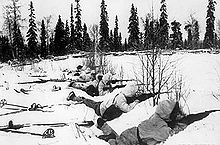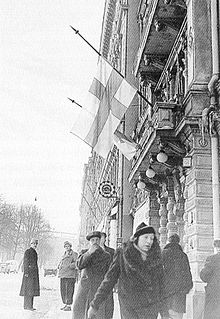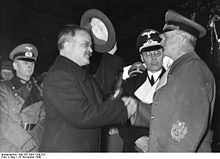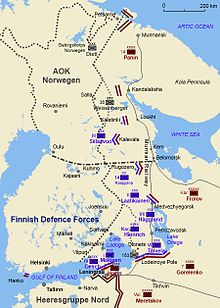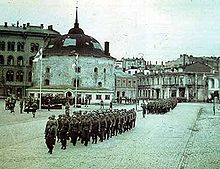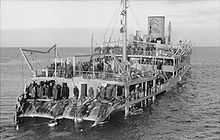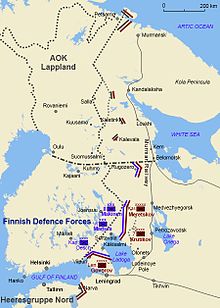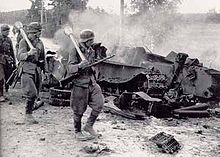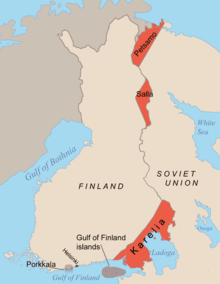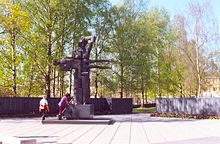- Continuation War
-
Continuation War Part of Eastern Front of World War II 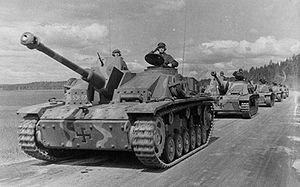
Finnish StuG III Ausf. G assault guns on parade.Date 25 June 1941 – 19 September 1944 Location Finland, Karelia and Murmansk Result Soviet victory[1] Territorial
changesConcession of Petsamo and rental of Porkkala to the Soviet Union Belligerents  Finland
Finland
 Germany
Germany
Minor belligerent:
 Italy1
Italy1 Soviet Union
Soviet Union
Minor belligerent:
 United Kingdom2
United Kingdom2Commanders and leaders  C.G.E. Mannerheim
C.G.E. Mannerheim
 Nikolaus von Falkenhorst (−7 Nov 1941)
Nikolaus von Falkenhorst (−7 Nov 1941)
 Eduard Dietl (7 Nov 1941-23 June 1944)
Eduard Dietl (7 Nov 1941-23 June 1944)
 Lothar Rendulic (28 June 1944–)
Lothar Rendulic (28 June 1944–) Markian Popov
Markian Popov
 Mikhail Hozin
Mikhail Hozin
 Valerian A. Frolov
Valerian A. Frolov
 Kirill Meretskov
Kirill Meretskov
 Leonid Govorov
Leonid GovorovStrength 530,000 Finns[Notes 1][2]
220,000 Germans[Notes 2]In June 1941: 450,390 (Northern Front and Baltic Fleet)[3]
In June 1944: 650,000[4]Casualties and losses Finnish:
63,204 dead or missing [Notes 3][5]
158,000 wounded
939 civilians in air raids[5]
190 civilians by Soviet partisans[5]
2,377–3,500 captured[Notes 4][6]German:
14,000 dead or missing
37,000 wounded[2]
Total
275,000 casualties265,000 dead or missing
(including 64,000 captured)
385,000 wounded
190,000 hospitalized due to sickness[7]
4,000–7,000 civilian deaths
Total
~835,000 casualties[7]1  Italy provided[Notes 5] four motor torpedo boats to lake Ladoga.
Italy provided[Notes 5] four motor torpedo boats to lake Ladoga.
2 United Kingdom[Notes 6] declared war on Finland but conducted only minor operations.
United Kingdom[Notes 6] declared war on Finland but conducted only minor operations.Naval warfare
Baltic Sea - Black Sea - Arctic - (Arctic Convoys - Rösselsprung - Wunderland)
1941
Barbarossa - (Białystok and Minsk - Smolensk - Uman - Leningrad - 1st Kiev - Sevastopol - Rostov - Moscow) - Finland - Chechnya
1942
Battles of Rzhev - (Toropets and Kholm - Demyansk - Velikiye Luki - Mars) - 2nd Kharkov - Case Blue - Stalingrad - (Uranus - Winter Storm)
1943
3rd Kharkov - Kursk - 2nd Smolensk - Lower Dnieper - 2nd Kiev
1944
Dnieper and Carpathian - Leningrad and Novgorod - Narva - Hube's Pocket - Crimea - Jassy-Kishinev - Karelia - Bagration - Lvov and Sandomierz - 2nd Jassy-Kishinev - Baltics - Debrecen - Petsamo and Kirkenes - Hungary
1945
Vistula and Oder - East Prussia - East Pomerania - Solstice - Silesia - Vienna - Berlin - Czechoslovakia - German capitulationContinuation War1941
Ladoga Karelia – Karelian Isthmus – East Karelia – Silver Fox – (Reindeer – Platinum Fox – Arctic Fox) – Petsamo – Hanko
1942
Suursaari – Someri
1944
1944 Soviet offensive – (Tienhaara – Tali and Ihantala – Vyborg Bay – Vuosalmi – Nietjärvi – Ilomantsi)
Naval warfareThe Continuation War (Finnish: jatkosota, Swedish: fortsättningskriget, 25 June 1941 – 19 September 1944) was the second of two wars fought between Finland and the Soviet Union during World War II.
At the time of the war, the Finnish side used the name to make clear its perceived relationship to the preceding Winter War.[9] The Soviet Union saw the war as a part of its struggle against Germany and its allies, the Eastern Front of World War II or, as it was known in the Soviet Union, the Great Patriotic War.[10] Germany regarded its operations in the region as a part of its overall war efforts of World War II. It provided critical material support and military cooperation to Finland.
Acts of war between the two countries started on 22 June 1941, the day Germany launched its invasion of the Soviet Union. Open warfare started with a Soviet air offensive on 25 June. Subsequent Finnish operations undid its post-Winter War cessations on the Karelian Isthmus and Ladoga Karelia, and captured East Karelia by September 1941. On the Karelian Isthmus, the Finns froze their offensive 30 km from Leningrad, where the pre-WW2 border of the Soviet Union and Finland ran. The Finns did not attack the city. Yet, they passively participated in the siege by holding their pre-WW2 land for two and a half years on the Karelian Isthmus.[11][12][13] The Soviet air forces bombed Helsinki and other major Finnish cities. Eventually the Soviet strategic offensive in the summer of 1944 drove the Finns from most of the territories they had gained during the war but the Finnish Army later fought it to a standstill in July 1944. Cease-fire ended the hostilities on 5 September and Moscow Armistice officially ending the hostilities was signed in 19 September. The Paris peace treaty concluded the war formally in 1947. Finland ceded Petsamo and rented Porkkala to the Soviet Union, and paid reparations of $300,000,000 equaling half of its annual gross domestic product in 1939, while Finland retained its independence.
Contents
Background
Winter War
On 23 August 1939, the Soviet Union and Germany signed the Molotov–Ribbentrop Pact where parties divided the independent countries of Finland, Estonia, Latvia, Lithuania, Poland and Romania into spheres of interest, with Finland falling to the Soviet sphere of interest.[14] Shortly afterward, Germany invaded Poland so the United Kingdom and France declared war against Germany. The Soviet Union invaded eastern Poland on 17 September.[15] Next, Moscow demanded that the Baltic states allow the establishment of Soviet military bases and the stationing of troops on their soil. The Baltic governments accepted ultimatums, signing the corresponding agreements in September and in October.[16]
In October 1939, the Soviet Union attempted to negotiate for Finnish territories on the Karelian Isthmus, the islands of the Gulf of Finland and a military base near the Finnish capital Helsinki.[17] The Finnish government refused, and the Red Army attacked on 30 November 1939.[18] Condemnation by the League of Nations and by countries all over the world had no effect on Soviet policy.[19] International help to Finland was planned, but very little actual help materialized, except from Sweden.[20] The Moscow Peace Treaty, which was signed on 12 March 1940, ended the Winter War.[21] According to the Treaty contract Finland lost one eleventh of its national territory and about 13 percent of its economic capacity.[22] However, Finland had avoided having the Soviet Union annex the whole country.[23]
Interim peace
The country's foreign policy had been based on multilateral guarantees for support from the League of Nations and Nordic countries and was considered a failure.[24] Public opinion favored the re-conquest of Finnish Karelia. The defence of the country was declared first priority and military expenditures rose to nearly half of government spending. Finland received war material purchased and donated during and immediately after the Winter War. On the southern frontier, the Soviet Union had acquired a military base in Hanko near the Finnish capital of Helsinki, employing over 30,000 military personnel.[25]
Finland also had to resettle some 420,000 evacuees from the lost territories. To ensure the supply of food, it was necessary to clear new land for them to cultivate.[25] This issue was facilitated with the Rapid Settlement Act. The Finnish leadership wanted to preserve the spirit of unanimity that was commonly felt throughout the country during the Winter War. The divisive White Guard tradition of the Civil War 16 May victory day celebration was therefore discontinued.[26] Relations between Finland and the Soviet Union remained strained despite the signing of the one-sided peace treaty and there were disputes regarding the implementation of the conditions of the treaty. Finland sought security against further territorial depredations by the Soviet Union and proposed mutual defence agreements with Norway and Sweden, but these initiatives were quashed by Moscow.[27][28]
German and Soviet expansion in Europe
After the Winter War, Germany was not popular in Finland as it was considered an ally of the Soviet Union. However, the Finnish government began to restore diplomatic relations with Germany. Finland continued its Western orientation policy and negotiated a war trade agreement with the United Kingdom[27] but the agreement was renounced after the German invasion of Denmark and Norway on 9 April, when Britain cut all trade and traffic communications with Scandinavia. With the fall of France, a policy of Western orientation was no longer considered an option in Finnish foreign policy.[29] On 15–16 June, the Soviet Union occupied the Baltic states without resistance. Puppet regimes were installed and within two months Estonia, Latvia and Lithuania were incorporated as Soviet Republics within the Soviet Union.[30] By mid-1940, both the northern democracies of Finland and Sweden were encircled by the totalitarian states of Germany and the Soviet Union.
On 23 June, a short time after the Soviet occupation in the Baltic states, the Soviet foreign minister Vyacheslav Molotov contacted the Finns and demanded a mining licence in the nickel mines in Petsamo for the Soviet Union or to a joint Soviet-Finnish company. The licence to mine the deposit had earlier been granted to a British-Canadian company and the proposition was rejected. Next month, the Soviets demanded Finland destroy the fortifications built in the Åland islands and give the right to use Finnish railways for transporting troops to the newly acquired Soviet base at Hanko. The Finns very reluctantly agreed to these demands.[31] On 24 July, Molotov accused the Finnish government of persecuting the so-called Society for Peace and Friendship between Finland and USSR, a pro-communist group, and soon after he publicly supported it. The society organized demonstrations, some of which turned into riots.[32][33]
Finnish relations with Germany and the USSR
On 31 July 1940, the German leader Adolf Hitler gave the order to start planning an assault on the Soviet Union. This meant that Germany had to re-assess the positions of both Finland and Romania. Until then, Germany had rejected Finnish appeals to purchase arms but in August the Germans allowed the secret sale of weapons. Military authorities made an agreement on 12 September and an official exchange of diplomatic notes were sent on 22 September. At the same time, German troops were allowed to transit their troop through Sweden and Finland.[34] In practice, this meant redrawing of the border between German and Soviet spheres of influence.[35]
Due to the changed situation, Molotov made a visit to Berlin on 12–13 November.[36] He wanted Germany to withdraw its troops from Finland and stop enabling Finnish anti-Soviet sentiments. He also reminded the Germans of the 1939 Soviet–German non-aggression pact. Hitler asked how the Soviet Union planned to settle the "Finnish question". Molotov answered that it would happen in the same manner as in Bessarabia and the Baltic states. Hitler rejected this.[37] Next December, the Soviet Union, Germany and the United Kingdom all voiced opinions concerning suitable Finnish presidential candidates. Risto Ryti was the only one of the candidates to whom none of three superpowers objected. He was elected on 19 December.[38]
In January 1941, the Soviet Union demanded to take control of the Petsamo mining area. Finland rejected this, as it had by then a re-built defense force and was encouraged by Germany to reject the Soviet demand.[38] On 18 December 1940, Hitler had officially approved Operation Barbarossa, the German invasion of the Soviet Union.[39] Both Finland and Romania were expected to join in the campaign.[40] Two days earlier, Finnish Major General Paavo Talvela had met German Colonel General Franz Halder and, a couple days later, Hermann Göring, in Berlin. This was the first time the Germans advised them, in carefully couched diplomatic terms, that they were preparing for a war with the Soviet Union. Outlines of the actual plan were revealed in January 1941 and regular contacts between Finnish and German military leaders started from February.[40]
In late Spring 1941, the Soviet Union made a number of goodwill gestures in order to prevent Finland from completely falling under German influence. Soviet ambassador Ivan Zotov was replaced with the more flexible Pavel Orlov. Furthermore, the Soviet government announced that it no longer opposed an approchement between Finland and Sweden. However, these conciliatory measures did not have effect on Finnish policy.[41]
Path to war
Finnish-German agreement
On 20 May, Germany invited Finnish officers to Germany to discuss the coordination of Operation Barbarossa. The participants met on 25–28 May in Salzburg and Berlin, and continued in Helsinki on 3–6 June. They agreed upon the arrival of German troops, Finnish mobilization and general division of operations.[41] It was also agreed that the Finnish Army would start mobilization on 15 June, but the Germans did not reveal the final date for the assault. The Finnish decisions were made by a small group of political and military leaders and the rest of the government was largely kept in the dark. They were not told until the 9th of June that the country would start mobilization of reservists due to tensions between Germany and the Soviet Union.[39]
Deployments and pre-assaults
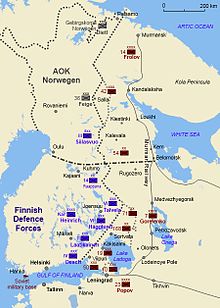 Finnish, German and Soviet troops at the start of the Continuation War in June/July 1941. The Germans assaulted on 29 June from Petsamo area and the Finns assaulted on 1 July from Suomussalmi and Kuusamo area.
Finnish, German and Soviet troops at the start of the Continuation War in June/July 1941. The Germans assaulted on 29 June from Petsamo area and the Finns assaulted on 1 July from Suomussalmi and Kuusamo area.
The Germans took responsibility for a 500 km (310 mi) stretch of the front in the northern Finland, the Finnish Lapland. The Finnish army was now much stronger than it had been during the Winter War. Its total strength was 475,000 men and the artillery was relatively strong. However, there was only one tank battalion and a lack of motorized transportation.[42]
At the beginning of the war, the Soviet Union had only eighteen divisions in the region, against fifteen Finnish and four German divisions. The Finns also enjoyed air supremacy. Furthermore, the Soviet Union needed its best units and most up-to-date materiel on its western front.[43]
The German troops assaulted the Soviet Union on 22 June elsewhere but not in Finland. However, German minelayers hiding in the Archipelago Sea laid two large minefields across the Gulf of Finland in the late hours of 21 June.[44][45] Later the same night, German bombers flew along the Gulf of Finland to Leningrad and mined the harbour and the river Neva. On the return trip, these bombers landed for refueling on an airfield in Utti. In the early hours of 22 June Finnish forces launched Operation Kilpapurjehdus that occupied the demilitarized Åland Islands. An international treaty on the status of the islands called for Finland to occupy them in case of a threat of an attack.[46] However the operation was coordinated with the Nazi invasion and the Soviet consulate there was arrested; Finland knew it had violated international norms.[47]
On 21 June, Finnish units began to concentrate at the Finnish-Soviet border, where they were arranged into defensive formations. Finland mobilised 16 infantry divisions, one cavalry brigade, and two jäger brigades, which were standard infantry brigades, except for an armoured battalion in the 1st Jäger Brigade. There were separate battalions mostly formed from border guard units and used mainly for reconnaissance. Soviet military plans estimated that Finland would be able to mobilise only 10 infantry divisions, as it had done in the Winter War, but they failed to take into account the materiel Finland had purchased between the wars and its training of all available men. Two German mountain divisions were stationed at Petsamo and two infantry divisions at Salla. On the morning of 22 June, the German Mountain Corps Norway began its advance from northern Norway to Petsamo. Finland did not allow direct German attacks from its soil into the Soviet Union. On the same day, another German infantry division was moved in from Oslo to face Ladoga Karelia.
The Karelian Isthmus was covered by the 23rd Army. Ladoga Karelia was defended by the 7th Army. In the Murmansk–Salla region, there was the 14th Army with the 42nd Corps. The Red Army also had around 40 battalions of separate regiments and fortification units present. Leningrad was garrisoned by three infantry divisions and one mechanized corps. As the initial devastating German strike against the Soviet Air Force had not affected air units located near Finland, the Soviets deployed 700 planes as well as some aircraft from the Navy against 300 Finnish planes.[48]
Campaign of 1941
In the morning of 25 June, the Soviet Union launched an air offensive of 460 fighter and bombers targeted against 19 airfields in Finland; however, inaccurate intelligence and bad bombing accuracy caused several raids to actually hit Finnish cities or municipalities.[49] There was considerable destruction in the cities and 23 planes were shot down. This offered the Finnish government a ground for claiming that the country had become the target of a new assault and the parliament approved the "defend war" as a fait accompli.[50] The message was more for public opinion in Finland than abroad, where it was seen that the country was in the German camp.[51] In 1941, most Finns thought it was only to regain back what had been wrongly taken in the Winter War.[52]
The Soviet Union claimed the air attack was directed against German targets, especially airfields, in Finland.[53] At the same time, Soviet artillery stationed at the Hanko base began to shell Finnish targets and a minor Soviet infantry attack was launched over the Finnish side of the border in Parikkala.
The Soviet Union was struggling to contain the German invasion and soon the Soviet High Command had to call all available units to the rapidly deteriorating front line.[54] Because of this, the initial air offensive against Finland could not be followed by a supporting land offensive in the scale originally planned.[55] Moreover, the 10th Mechanized Corps and the 237th Infantry Division were withdrawn from Ladoga Karelia, thus stripping reserves from the remaining defending units.[56]
Reconquest of Ladoga Karelia
The Finnish plans for the offensive in Ladoga Karelia were completed on 28 June.[57] It was launched on 10 July[57][58][59] and by 16 July it had already reached the shore of Lake Ladoga and cut the defending Soviet army in two, hindering the Soviet defense of the area[57]. Finnish HQ halted the offensive in Ladoga Karelia on 25 July after reconquering the area of Ladoga Karelia lost to Soviet Union in 1940 and advancing as far as Vitele, and then moved onto the offensive at other sections of the front.
Reconquest of the Karelian Isthmus
Finnish II Corps (II AK) started offensive in the region of the Karelian Isthmus on 31 July.[60][61] Finnish troops reached the shores of lake Ladoga on 9 August, surrounding most of three defending Soviet divisions on the north-western coast of the lake from where they were evacuated across the lake. On 22 August Finnish IV AK started its offensive from the 1940 border between the Gulf of Finland and II AK and advanced towards Viipuri.[60] By 23 August, the Finnish II Corps had reached the Vuoksi waterway from the east and continued to surround the Soviet forces defending Viipuri.[60] The Soviet withdrawal order came too late, and divisions lost much of their equipment, although a sizable portion of their manpower was later evacuated via the Koivisto islands. The badly mauled defending Soviet army was unable to halt the Finnish offensive, and by 2 September they had reached the 1939 border along its whole length. On 31 August, Finnish HQ ordered the offensive to halt at a straightened line just past the former border.[62] However, according to Soviet sources the Finns advanced and took the settlement of Novyi Beloostrov on 4 September, but a Soviet counter-attack threw them out the next day,[63][64] although the war diary of the Finnish 12th Division facing the settlement[62] does not mention the fighting and notes that it was quiet at the time[65] while the neighboring 18th Division gave clear orders on the morning of 4 September 1941 not to advance to N. Beloostrov.[66] Neither does Finnish chronology of the Continuation War mention fighting at N. Beloostrov on 4-5 September 1941.[67] Staryi Beloostrov (Valkeasaari) was taken by the Finns on September 4 and the Soviet counterattacks failed to retake the settlement.[62] The Finns took Novyi Beloostrov on 11 September. This created a dangerous bulge in the Soviet defensive line.[64] Fighting for the settlement continued until 20 September when the Soviets managed to force the Finns out.[68] After that the front stabilized.[69][70]
Conquest of East Karelia
Finnish offensive in East Karelia started in early July in the northern section of the front. In early September, the attack in the northern section reached the Rukajärvi (Ругозеро, Rugozero) village and HQ halted the offensive there. In the southern area on August 27, Finnish HQ ordered the offensive to reach Svir river. Finnish troops cut the Kirov railroad on 7 September and crossed the Svir on 15 September and then halted the offensive. Advance troops reached shores of Lake Onega on 24 September and the town of Petrozavodsk was captured on 1 October after the Soviets withdraw from the town to avoid encirclement. On 6 November, the Finnish HQ ordered their forces to capture Karhumäki and then move to defense. The Finnish forces captured the area of Karhumäki and Povenets and halted the offensive in early December.
Related to Finnish advance to Svir the German Army Group North advanced from the south towards Svir river and managed to capture Tikhvin before Soviet counterattacks forced the Germans to withdraw to Volkhov River. Soviet forces also made several attempts to force Finns out from their bridgehead south of Svir during October and December 1941 however the Soviet efforts to reduce the bridgehead were blocked by the Finns. Soviet forces also attacked against the German 163rd Division – which was operating under Finnish command – across the Svir in October 1941 but the Soviet forces which had crossed the river were pushed back soon after.[71]
Operation Silver Fox on the North
The German objective in northern Finland was to take Murmansk and seize control of the Murman Railway. Murmansk was the only ice-free port year round in the north and a threat to the nickel mine of Petsamo. The Operation Silver Fox was run by the German AOK Norwegen and had two Finnish divisions under its command. The German soldiers were from central Europe and they had difficulties moving over a roadless terrain of swamp and forest. Troops managed to advance some distance with heavy casualties, but the terrain offered good defensive positions for the Soviet resistance.[72]
The order for German–Finnish troops to move to defensive operations was given on 17 November and attempts to reach the Murman Railway had failed.
Though the Red Banner Baltic fleet started the war in a strong position, the naval mine warfare, aerial supremacy and rapid changes to the land forces forced Soviet Navy to evacuate its bases to Kronstadt and Leningrad. Evacuations from Tallinn and Hanko proved to be very costly operations. As the Soviet Navy withdrew to the eastern end of the Gulf of Finland it left the nearly the whole of the Baltic Sea as well as many of the islands to the Germans and the Finns. Though submarines caused some threat to German traffic on the Baltic, the withdrawal of the Soviet Navy made the Baltic Sea a 'German lake' until the second half of 1944. Though the Soviet navy left in a hurry, the naval mines it had managed to lay before and during the evacuations caused casualties both to the Germans and to the Finns, including the loss of one of the two Finnish coastal defence ships, the Ilmarinen.
Political development
The main forces of Germany advanced rapidly deep into the Soviet territory during the first weeks of campaign. The Finns believed the Germans would defeat the Soviet Union soon. President Ryti visionized Greater Finland, where the country and other Finnic people would live inside "natural defence borderline" by incorporating the Kola Peninsula, East Karelia and perhaps even northern Ingria. In public the proposed frontier was introduced by the slogan "A short border – a long peace".[73] Some members of parliament opposed the idea, such social democrats and Swedish-speaking party people, and argument that 1939 frontier would be enough.[73] The Commander-in-Chief C.G.E. Mannerheim gave an order of the day on 10 July, the Sword scabbard declaration, in which he pledged to liberate Karelia. The Finnish government assured to Americans that it was unaware of the order.[74]
Finland had prepared for a short war, but in late autumn it was clear that there was no decisive outcome in the short term. The Finnish troops suffered losses during its advance, and overall German victory became unsure as their troops were halted near Moscow. The Finnish economy suffered from a lack of labour, food shortages and increased prices. The Finnish government had to demobilize part of the army so that industrial and agricultural production would not collapse.[75] In October, the Finns informed Germany that it would need 175,000 short tons (159,000 t) of grains to manage till next year's harvest. German authorities would have rejected the request, but Hitler himself agreed. The annual grain deliveries 200,000 short tons (180,000 t) amounted to almost ½ of the Finnish domestic crop. In November Finland decided to join the Anti-Comintern Pact.[76] The advance in East Karelia was halted on 6 December. The Finns had suffered 75,000 casualties of whom 25,000 died during the advance.[75]
Finland and Western Allies
Finland worked to maintain good relations with the Western powers. The government stressed that Finland was fighting as a co-belligerent of Germany only against the Soviet Union to protect itself.[75] Furthermore, Finland stressed that it was still the same democratic country as it had been in the Winter War. However, the United Kingdom had signed with the Soviet Union an agreement of joint action on 12 July. Furthermore, Finland had to close, under German pressure, the British legation in Helsinki. As a result, diplomatic relations between Finland and the United Kingdom were broken on 1 August.[77] On 28 November, Britain presented Finland an ultimatum, in which it demanded that Finland cease military operations by 3 December.[78] Unofficially Finland informed the Western powers that troops would halt their advance in the next few days. The reply did not satisfy the United Kingdom. It declared war on Finland on 6 December, following Commonwealth countries of Canada, Australia, India and New Zealand.[79]
Relations between Finland and the United States were more complex. The American public was sympathetic to the 'brave little democracy' and there were still anti-communist feelings. At first, the U.S. empathised with the Finnish cause; however, the situation became problematic after Finnish troops crossed the 1939 border. Finnish and German troops were a threat to the Murmansk Railway and northern communication supply line between the Western Allies and the Soviet Union.[80] On 25 October, the U.S. demanded that Finland cease all hostilities against the Soviet Union and withdraw behind the 1939 border. In public President Ryti rejected the demands, but in private he wrote Mannerheim on 5 November asking him to halt the offensive. Mannerheim agreed and secretly instructed General Hjalmar Siilasvuo to break off the assault against the Murmansk Railway.[78]
1942–1943: Trench warfare
Military operations
Though military operations during 1942–1943 were limited, the front did see some action. In early 1942, Soviet Karelian Front forces attempted to retake the Medvezhyegorsk which had been lost to the Finns in late 1941. As the spring came, the Soviet forces also went onto the offensive in the Svir front as well as in Kiestinki region. All Soviet offensives started promisingly but either due to overextending their lines or by stubborn resistance, the Soviet offensives were stopped and repulsed. After Finnish and German (in Kiestinki) counterattacks, the eventual front lines had moved very little. On September 1942, the Soviets tried again at Kriv near Medvezhyegorsk, but despite of five days of fighting, the Soviets managed to push back the Finnish lines only 500 m (550 yd) on a roughly 1 km (0.62 mi)-long stretch of the front.[81]
Unconventional warfare was fought in both the Finnish and Soviet wilderness. Finnish LRRPs organized both by Finnish HQ—4th Separate Battalion (Er.P 4)—and by local units patrolled beyond Soviet lines. In the summer of 1942, the Soviet Union had formed the 1st Partisan Brigade. The unit was only 'partisan' in the name as it was essentially more than 600 men and women on long range patrol. The 1st Partisan Brigade was able to infiltrate beyond Finnish patrol lines but was found out and largely destroyed.[82]
On the naval front, the Soviet Baltic Fleet still operated from the besieged city of Leningrad. In early 1942, Soviet forces recaptured the island of Gogland but lost both Gogland and Bolshoy Tyuters to the Finns later in the spring of 1942. During the winter of 1941/1942, the Soviet Baltic Fleet made the decision to use the large Soviet submarine fleet to carry the fight to the enemy. Though initial submarine operations in the summer of 1942 were successful, the German Kriegsmarine and Finnish Navy soon stepped up their anti-submarine efforts, making the Soviet submarine operations later in 1942 very costly. The underwater offensive carried out by the Soviets convinced the Germans to lay anti-submarine nets as well as supporting minefields between Porkkala and Naissaar which proved to be an insurmountable obstacle for the Soviet submarines.[83]
Diplomatic manoeuvers
Operation Barbarossa was planned as a blitzkrieg intended to last a few weeks. British and U.S. observers believed that the invasion would be concluded before August.[citation needed] In the autumn of 1941, this turned out to be wrong, and leading Finnish military officers started to doubt Germany's capability to finish the war quickly. German troops in Northern Finland faced circumstances they were not properly prepared for, and failed to reach their targets, most importantly Murmansk. As the lines stabilized, Finland sent out peace feelers to the Soviet Union several times.[84] Germany was alarmed by this, and reacted by drawing down shipments of desperately needed materials each time. The idea that Finland had to continue the war while putting its own forces in the least possible danger gained increasing support, perhaps in the hope that the Wehrmacht and the Red Army would wear each other down enough for negotiations to begin, or to at least get them out of the way of Finland's independent decisions. Nationalist elements, including the IKL, may also have continued to hope for an eventual victory by Germany.
Finland's participation in the war brought major benefits to Germany. The Soviet fleet was blockaded in the Gulf of Finland, so that the Baltic was freed for the training of German submarine crews as well as for German shipping, especially for the transport of vital iron ore from northern Sweden and nickel and rare metals (needed in steel processing) from the Petsamo area. The Finnish front secured the northern flank of the German Army Group North in the Baltic states. The sixteen Finnish divisions tied down numerous Soviet troops, put pressure on Leningrad (although Mannerheim refused to attack it directly), and threatened the Murmansk railway. Additionally, Sweden was further isolated and was increasingly pressured to comply with German and Finnish wishes, though with limited success.[citation needed]
Despite Finland's contributions to the German cause, the Western Allies had ambivalent feelings, torn between residual goodwill for Finland and the need to accommodate their vital ally, the Soviet Union. As a result, Britain declared war against Finland, but the U.S. did not. With few exceptions, there was no combat between these countries and Finland, but Finnish sailors were interned overseas. In the U.S., Finland was denounced for naval attacks made on American Lend-Lease shipments, but received approval for continuing to make payments on its World War I debt throughout the inter-war period.
Because Finland joined the Anti-Comintern Pact and signed other agreements with Germany, Italy, and Japan, the Allies characterized Finland as one of the Axis Powers, although the term used in Finland is "co-belligerence with Germany", emphasizing the lack of a formal military alliance treaty.
International volunteers and support
Like in the Winter War, Swedish volunteers were recruited. Until December they were tasked with guarding the Soviet naval base at Hanko. When it was evacuated by sea in December 1941, the Swedish unit was officially disbanded. During the Continuation War, the volunteers signed for three to six months of service. In all, over 1,600 fought for Finland, though only about 60 remained by the summer of 1944. About ⅓ of the volunteers had previously participated in the Winter War. Another significant group—about ¼ of the men—were Swedish officers on leave.
From 1942 to 1944 there was also a Schutzstaffel (SS) battalion of volunteers on the northern Finnish front that was recruited from Norway, then under German occupation, and similarly, a some Danes. About 3,400 Estonian volunteers took part. On other occasions, the Finns received around 2,100 Soviet prisoners of war in return for those POWs they turned over to the Germans. These POWs were mainly Estonians and Karelians who were willing to join the Finnish army. These, as well as some volunteers from occupied Eastern Karelia, formed the Kinship Battalion (Finnish: "Heimopataljoona"). At the end of the war the USSR requested members of the Kinship Battalion to be handed over. Some managed to escape before or during transport, but most of them were either sent to the labor camps or executed.
Finnish occupation policy
Main articles: Finnish military administration in Eastern Karelia and East Karelian concentration campsOn 19 July 1941, the Finns set up the military administration in the occupied East Karelia. The goal of the administration was to prepare the region for eventual incorporation into Finland. In the early stage, the Finns aimed at ethnic cleansing where the Russian population would be moved out of the area once the war was over. They would be replaced with Finnic peoples such as Karelians, Finns, Estonians, Ingrians, and Vepsians. The Russian population was deemed "non-national".[85] Most of the East Karelian population had been evacuated before the Finnish forces arrived. About 85,000 people — mostly the elderly, women and children — were left behind, and less than ½ of them were Karelians. A significant number of civilians —almost 30% of the remaining Russians — were interned in concentration camps.[85]
The winter of 1941–1942 was hard for the Finnish urban population due to poor harvests and a shortage of agricultural laborers.[85] However, for the interned it was disastrous and over 3,500 of them died, mostly from famine. The figure was equivalent to 13.8% of the inmates, where the corresponding figure for the free population of the occupied territories was 2.6% and for Finland proper 1.4%.[86] Conditions were gradually improved, and the following year ethnic discrimination in wage levels and food rations was terminated, and schools were established also for the Russian section of the population.[87] By the end of the occupation the death rate dropped to the same level as in Finland proper.[86]
Soviet partisans
Soviet partisans conducted a number of operations in Finland and in Eastern Karelia from 1941 to 1944. The major one failed when the 1st Partisan Brigade was destroyed in the beginning of August 1942 at lake Seesjärvi. Partisans distributed propaganda newspapers, "Pravda" in Finnish and "Lenin's Banner" in Russian. One of the leaders of the partisan movement in Finland and Karelia was Yuri Andropov.[88]
Finnish sources state that partisan activity in East Karelia focused mainly on Finnish military supply and communication targets, but almost two thirds of the attacks on the Finnish side of the border targeted civilians,[89] killing 200 and injuring 50, including children and the elderly.[90][91][92]
Jews in Finland
Main article: Jews in FinlandFinland had a small (approx. 2,300) jewish population. They had full civil rights and fought shoulder to shoulder with other Finns in the ranks of the Finnish Army. The Germans had mentioned the Finnish Jews at the Wannsee Conference in January 1942, wishing to transport them to Majdanek in General Gouvernment. SS leader Heinrich Himmler mentioned the Finnish Jews during his visit in Finland in the summer of 1942. Finnish Prime Minister Jukka Rangell replied that Finland had no Jewish question.[93] However, there were differences for Jewish refugees in Finland. In November 1942, the Finns handed eight Jewish refugees over to the Gestapo. This raised protests among the Finnish Social Democrat ministers, and after this no more refugees were handed over.[94] Over 500 Jewish refugees were granted asylum.[95]
The field synagogue in Eastern Karelia was one of the very few functioning synagogues on the Axis side during the war. There were even several cases of Jewish officers of Finland's army awarded the German Iron Cross, which they declined. German soldiers were treated by Jewish medical officers who succeeded in saving their lives.[96][97][98][99]
Finland and the Western Allies
The Continuation War represents the only case of a genuinely democratic state participating in World War II on the side of the Axis powers, albeit without being a signatory of the Tripartite Pact. The United Kingdom declared war on Finland on 6 December 1941 (Finnish Independence Day), with Canada and New Zealand declaring war on Finland on 7 December and Australia and South Africa declaring war the next day. The U.S. Secretary of State Cordell Hull congratulated the Finnish envoy on 3 October 1941 for the liberation of Karelia but warned Finland not to enter Soviet territory; furthermore, the U.S. did not declare war on Finland when they went to war with the Axis countries and, together with UK, approached Stalin in the Tehran Conference about acknowledging Finnish independence. However, the U.S. government seized Finnish merchant ships in American ports, and in the summer of 1944 shut down Finnish diplomatic and commercial offices in the U.S. as a result of President Ryti's treaty with Germany. The U.S. government later warned Finland about the consequences of continued adherence to the Axis.[100]
The best-known British action on Finnish soil was an aircraft carrier strike on German and Finnish ships in the Finnish harbour of Petsamo on 31 July 1941.[8] This attack achieved little except the loss of three British aircraft, but it was intended as a demonstration of British support for its Soviet ally. Later in 1941, Hurricanes of No. 151 Wing RAF, based at Murmansk, provided local air cover for Soviet troops and fighter escorts for Soviet bombers.[101] The British contribution to the war was occasional but significant.
Finnish radio intelligence is said to have participated effectively in German actions against British convoys to Murmansk.[102] Throughout the war, German aircraft operating from airfields in northern Finland attacked British air and naval units based in Murmansk and Archangelsk.
1944: Soviet offensive
Overtures for peace
Finland began to actively seek a way out of the war after the disastrous German defeat at the Battle of Stalingrad in February 1943. Edwin Linkomies formed a new cabinet with peace as the top priority. Negotiations were conducted intermittently in 1943–44 between Finland and its representative—Juho Kusti Paasikivi—on one side and the Western Allies and the Soviet Union on the other, but no agreement was reached. Stalin decided to force Finland to surrender; a bombing campaign on Helsinki followed. The air campaign in February 1944 included three major air attacks involving a total of over 6,000 sorties. Finnish anti-aircraft defences managed to repel the raids as only 5% of the dropped bombs hit their planned targets. Major air attacks also hit Oulu and Kotka but, because of radio intelligence and effective anti-aircraft defences, the number of casualties was small.[103]
Meanwhile, the lengthy and ferocious German defence in Narva aided by Estonians denied a Soviet-occupied Estonia as a favorable base for amphibious invasions and air attacks against Helsinki and other Finnish cities. The tactical success of the army detachment "Narwa" from mid-February to April diminished the hopes of the Stavka to assault Finland and force it into capitulation from Estonia.[104][105][106] Finland terminated the negotiations in mid-April 1944[107] when it became apparent that Soviet terms were impossible to fulfill.[108]
Soviet strategic offensive
On 9 June 1944, the Soviet Union opened a major offensive against Finnish positions on the Karelian Isthmus and in the area of Lake Ladoga (it was timed to accompany D-Day[109]). On the 21.7 km (13.5 mi)-wide breakthrough segment the Red Army had concentrated 3,000 guns and mortars. In some places, the concentration of artillery pieces exceeded 200 guns for every kilometer of the front (one every 5 m (5.5 yd)). On that day, Soviet artillery fired over 80,000 rounds along the front on the Karelian Isthmus. On the second day of the offensive, the Soviet forces broke through the Finnish front lines. The Soviets penetrated the second line of defence by the sixth day. The Soviet pressure on the Karelian Isthmus forced the Finns to reinforce the area. This allowed the second Soviet offensive in Eastern Karelia to meet less resistance and to capture Petrozavodsk by 28 June 1944. The main objective of the offensives was to force Finland from the war.[110]
Finland especially lacked modern antitank weaponry which could stop Soviet heavy tanks, and German Foreign Minister Joachim von Ribbentrop offered these in exchange for a guarantee that Finland would not seek a separate peace again. On 26 June, President Risto Ryti gave this guarantee as a personal undertaking, which he intended to last for the remainder of his presidency. In addition to delivering thousands of hand-held Panzerfaust and Panzerschreck antitank weapons (German equivalents of American bazookas), Hitler sent the 122nd Infantry Division, ½-strength 303rd Assault Gun Brigade, and a Luftwaffe Gefechtsverband Kuhlmey to provide temporary support in the most threatened defense sectors.
With new supplies from Germany, the Finnish army halted the Soviet advance in early July 1944. At this point, the Finnish forces had retreated about one hundred kilometres, which brought them to approximately the same line of defence they had held at the end of the Winter War. This line was known as the VKT-line (short for "Viipuri–Kuparsaari–Taipale", running from Viipuri to River Vuoksi to Lake Ladoga at Taipale), where the Finnish Army stopped the Soviet offensive in the Battle of Tali-Ihantala in spite of the Soviet numerical and material superiority.[111][112][113] The front stabilized once again.[111][112][113] A few battles were fought in the latter stages of the war. The last of them was the Battle of Ilomantsi, a Finnish victory, from 26 July to 13 August 1944.[114][108][115][116] The struggle to contain the Soviet offensive was exhausting Finnish resources. The German support under the Ryti-Ribbentrop Agreement had prevented a disaster, but the country would not be able to hold another major attack.[117] The Soviet advances against German Army Groups Center and North further complicated matters for Finland.[117] With the front being stable so far, it was a good time for Finland to seek a way out of the war.[117][118][119] By the beginning of August President Ryti resigned to allow Finland to sue for peace again, which the new government did in late August.[110][118][120] The Soviet peace terms were harsh but the $600,000,000 reparations demanded in the Spring were reduced to $300,000,000,[108] most likely due to pressure from the US and Britain.[121] However, after the ceasefire the Soviets insisted that the payments should be based on 1938 prices, which doubled the amount.[121]
Prisoners of war
Soviet prisoners of war in Finland
Main article: Soviet prisoners of war in FinlandThe number of Soviet prisoners of war was estimated to be around 64,000 persons. Of these, 56,000 were captured in 1941.[122] About 2,600–2,800 Soviet prisoners of war were handed over to the Germans in exchange for roughly 2,200 Finnic prisoners of war.[123] Food was especially scarce in 1942 in Finland due to a bad harvest, and this was the primary reason for the number of deaths. Out of 64,188 Soviet POWs, 18,318 died in Finnish prisoner of war camps.[124]
Finnish prisoners of war in the Soviet Union
There are two views of the number of Finnish prisoners of war. The Soviet and Russian view is that of 2,377 Finnish prisoners of war who reached the prison camps 1,954 were returned after Moscow Armistice. The Finnish view is that of original ~3,500 prisoners of war only ~2,000 were returned (more than 40% perished). The difference can be at least partially explained by Soviet practice of counting only the prisoners who survived to reach a prison camp.
Armistice and aftermath
Mannerheim had repeatedly reminded the Germans that in case their troops in Estonia retreated, Finland would be forced to make peace even on extremely unfavourable terms.[125] The territory of Estonia would have provided the Soviet army with a favourable base for amphibious invasions and air attacks against Finland's capital, Helsinki, and other strategic targets in Finland, and would have strangled Finnish access to the sea. The initial German reaction to Finland's announcement of ambitions for a separate peace was limited to only verbal opposition. However, the Germans arrested hundreds of sailors on Finnish merchant ships in Germany, Denmark and Norway.
Previously, in return for critically needed food and defense materiel from the Germans, President Ryti had personally committed, in writing, that no separate peace with the Soviets would be attempted. Accordingly, it became clear that he must resign, paving the way for a separate peace. Finland's military leader and national hero, Carl Gustaf Emil Mannerheim, was extraordinarily appointed president by the parliament, accepting responsibility for ending the war.
On 4 September, the cease-fire ended military actions on the Finnish side. The Soviet Union ended hostilities exactly 24 hours after the Finns. An armistice between the Soviet Union and Finland was signed in Moscow on 19 September. Finland had to make many concessions: the Soviet Union regained the borders of 1940, with the addition of the Petsamo area (now Pechengsky District, Russia); the Porkkala peninsula (adjacent to Helsinki) was leased to the USSR as a naval base for fifty years and transit rights were granted; Finland's army was to be demobilized with haste, and Finland was required to expel all German troops from its territory within 14 days. As the Germans did not leave Finland in time for the given deadline, the Finns fought their former allies in the Lapland War. Finland was also to clear the minefields in Karelia (including East Karelia) and in the Gulf of Finland. Retreating German forces had also mined northern Finland heavily. The demining was a long operation, especially in the sea areas, lasting until 1952. 100 Finnish army personnel were killed and over 200 wounded during this process, most of them in Lapland.
Nevertheless, in contrast to the rest of the Eastern front countries, where the war was fought to the end, a Soviet occupation of Finland did not occur and the country retained sovereignty. Neither did Communists rise to power as they had in the Eastern Bloc countries. A policy called the Paasikivi–Kekkonen line formed the basis of Finnish foreign policy towards the Soviet Union until its dissolution in 1991.
Analysis
 353,240 Soviet personnel were awarded this medal for the defence of the Soviet Transarctic from 5 December 1944
353,240 Soviet personnel were awarded this medal for the defence of the Soviet Transarctic from 5 December 1944
 Mannerheim Cross is the most distinguished Finnish military decoration and awarded to soldiers for extraordinary bravery; the achievement of extraordinarily important objectives by combat, or for especially well conducted operations.
Mannerheim Cross is the most distinguished Finnish military decoration and awarded to soldiers for extraordinary bravery; the achievement of extraordinarily important objectives by combat, or for especially well conducted operations.
Finland was forced into World War II by the Soviet invasion of Finland during the Winter War, despite the Finnish intention of relying on the League of Nations and Nordic neutrality to avoid conflicts.[126] During the Continuation War, Finland primarily aimed at reversing its territorial losses under the March 1940 Moscow Peace Treaty and, depending on the success of the German invasion, possible expansion, especially into East Karelia (Karelo-Finnish Soviet Socialist Republic).[127] Some small right-wing groups also supported a Greater Finland ideology. Finland was able to come out of World War II without losing its independence,[128] although the price for war was high in war casualties, reparation payments, territorial loss, a bruised international reputation, and subsequent careful consideration of Soviet international perspectives during the Cold War. The Finnish–German alliance was different from most of the other Axis relationships, an example of which is represented by the participation of Finnish Jews in the fight against the Soviet Union.[129] The Finns did not take any anti-Jewish measures in Finland, despite repeated requests from Nazi Germany.[130] One remarkable aspect of the Finnish-German relationship was that Finland never signed the Tripartite Pact, which was signed by all de jure Axis countries. However, for Hitler the matter was irrelevant and he saw Finland as an ally.[93]
Finland adopted the concept of a "parallel war" whereby it sought to pursue its own objectives in concert with, but separate from, Nazi Germany.
Major events of World War II, and the tides of war in general, had a significant impact on the course of the Continuation War:
- Germany's invasion of the Soviet Union (Operation Barbarossa) is closely connected to the Continuation War's beginning.
- The Allied invasion of France (Battle of Normandy) was coordinated with the Soviet major offensive against Finland (9 June-15 July 1944).[84]
- The subsequent Soviet and Allied advances towards Germany drew away the interest in military operations from Northern Europe hastening the end of the Continuation War.
Soviet sources maintain that Soviet policies up to the Continuation War were best explained as defensive measures by offensive means: the division of occupied Poland with Germany, the occupation of Lithuania, Latvia and Estonia, and the invasion of Finland in the Winter War are described as elements in the construction of a security zone or buffer region between the perceived threat from the capitalist powers of Western Europe and the Communist Soviet Union—as some see the post-war establishment of Soviet satellite states in the Warsaw Pact countries and the Agreement of Friendship, Cooperation, and Mutual Assistance concluded with post-war Finland.[131][132][133] Western historians such as Norman Davies and John Lukacs dispute this view and describe the prewar Soviet policy as attempting to stay out of the war and regaining land lost after the fall of the Russian Empire.[134]
See also
- List of Finnish corps in the Continuation War
- List of Finnish divisions in the Continuation War
- Finnish prisoners of war in the Soviet Union
- Co-belligerence
- Einsatzkommando Finnland
- Finlandization
- Finnish Waffen-SS volunteers
- Paasikivi–Kekkonen line
- Salpalinja
- No. 151 Wing RAF
- Karelian question in Finnish politics
Notes
- ^ Most of the Finns served during the Finnish offensive in 1941 (approx. 500,000 men) and the Soviet offensive in August 1944 (528,000 men). Army strength varied from 260,000 to 360,000, Air Force 8,000–22,000, Navy 14,000–40,000 and directly under the HQ command 15,000–36,000. In addition some people were obliged by law to provide supporting tasks, like 19,000 in labour groups and 25,000 men in air-raid defence (fire brigades, air-raid shelter maintenance etc.), and 43,000 women volunteers in various non-military tasks (clercks, radio-operators, air-observers, supply).
- ^ Germans were located in Finnish Lapland executing the Operation Silver Fox.
- ^ Finnish detailed death casualties: Dead, buried 33,565; Wounded, died of wounds 12,820; Dead, not buried later declared as dead 4,251; Missing, declared as dead 3,552; Died as prisoners of war 473; Other reasons (diseases, accidents, suicides) 7,932; Unknown 611
- ^ The official Soviet number was 2,377 POWs. Finnish researchers have estimated 3,500 POWs.
- ^ Italian participation was limited to four motor torpedo boats and their crews which were used alongside already obsolete Finnish motor torpedo boat Sisu and four German minelaying KM-boats to for international Naval Detachment K which operated on lake Ladoga during the summer and autumn of 1942.
- ^ Although the United Kingdom formally declared war on Finland on 6 December 1941, there was only one British attack on Finnish soil — a carrier strike on Petsamo[8] carried out on 31 July 1941 four months before the declaration of war. Additional British participation in the Continuation War was limited to supply aid, aerial support for its Arctic operations and a British airwing (No. 151 Wing RAF) under Soviet command, which supported Soviet air raids in the Murmansk area and trained Soviet crews for roughly a month in the autumn of 1941 - couple of months before the declaration of war against Finland by the United Kingdom.
References
Citations
- ^ Mouritzen, Hans (1997). External danger and democracy: old Nordic lessons and new European challenges. Dartmouth. pp. 35. ISBN 1855218852. http://books.google.com/books?cd=4&id=O7COAAAAMAAJ&q=soviet+victory#search_anchor.
- ^ a b Maanpuolustuskorkeakoulun historian laitos, Jatkosodan historia 1–6 ("The History of The Continuation War, 1–6"), 1994
- ^ Кривошеев, ed (2001) (in Russian). Россия и СССР в войнах ХХ века. Олма-Пресс. pp. 269–271. ISBN 5-224-01515-4. http://lib.ru/MEMUARY/1939-1945/KRIWOSHEEW/poteri.txt.
- ^ Manninen (1994) p.277-282
- ^ a b c Kurenmaa, Pekka; Lentilä, Riitta (2005). "Sodan tappiot". In Leskinen, Jari; Juutilainen, Antti (in Finnish). Jatkosodan pikkujättiläinen (1st ed.). Werner Söderström Osakeyhtiö. pp. 1150–1162. ISBN 951-0-28690-7.
- ^ Malmi, Timo (2005). "Jatkosodan suomalaiset sotavangit". In Leskinen, Jari; Juutilainen, Antti (in Finnish). Jatkosodan pikkujättiläinen (1st ed.). Werner Söderström Osakeyhtiö. pp. 1022–1032. ISBN 951-0-28690-7.
- ^ a b Manninen (1994) p.306-313
- ^ a b FAA archive: Raid on Petsamo
- ^ Jason Edward Lavery. The history of Finland. Greenwood Press. p. 126.
- ^ Great Soviet Encyclopedia, Finland, Moscow, 1974. ISBN 0-02-880010-9
- ^ Wykes, Alan (1972). The Siege of Leningrad, Ballantines Illustrated History of WWII.
- ^ Brinkley, Douglas; Haskey M. (2004). The World War II. Desk Reference. Grand Central Press. p. 210.
- ^ Барышников, Н. (2002). "Финские бомбардировщики в зоне Ленинграда" (in russian). Блокада Ленинграда и Финляндия 1941–44. Хельсинки. ISBN 952-5412-10-5. http://v-n-baryshnikov.narod.ru/blokada.html.
- ^ Vehviläinen 2002, p. 30
- ^ Vehviläinen 2002, p. 31
- ^ Vehviläinen 2002, p. 33
- ^ Vehviläinen 2002, p. 39
- ^ Vehviläinen 2002, p. 44
- ^ Vehviläinen 2002, p. 49
- ^ Vehviläinen 2002, p. 65
- ^ Vehviläinen 2002, p. 69
- ^ Kirby 2006, p. 215
- ^ Vehviläinen 2002, p. 70
- ^ Vehviläinen 2002, p. 74
- ^ a b Vehviläinen 2002, p. 75
- ^ Vehviläinen 2002, p. 76
- ^ a b Vehviläinen 2002, p. 77
- ^ Kirby 2006, p. 216
- ^ Vehviläinen 2002, p. 78
- ^ Vehviläinen 2002, p. 79
- ^ Vehviläinen 2002, p. 80
- ^ Vehviläinen 2002, p. 81
- ^ Kirby 2006, p. 218
- ^ Kirby 2006, p. 220
- ^ Vehviläinen 2002, p. 83
- ^ Kirby 2006, p. 219
- ^ Vehviläinen 2002, p. 84
- ^ a b Vehviläinen 2002, p. 85
- ^ a b Kirby 2006, p. 221
- ^ a b Vehviläinen 2002, p. 86
- ^ a b Vehviläinen 2002, p. 87
- ^ Vehviläinen 2002, p. 90
- ^ Vehviläinen 2002, p. 91
- ^ (Finnish) Nordberg, Erkki, Arvio ja ennuste Venäjän sotilaspolitiikasta Suomen suunnalla, 2003, ISBN 951-884-362-7
- ^ Encyclopædia Britannica Premium, 2006, Finland
- ^ "Ahvenanmaansaarten linnoittamattomuutta ja puolueettomuutta koskeva sopimus.". Finlex – Finnish legistation. 28.01.1922. http://www.finlex.fi/fi/sopimukset/sopsteksti/1922/19220001. Retrieved 3 August 2011. "7th Article, section II. If a sudden (surprise) attack against Åland or against Finnish mainland via Åland could place the neutrality of the zone in jeopardy Finland must take necessary precautions in the zone to halt or ward off the attacker..."
- ^ Jokipii 1999, p. 282
- ^ Jokipii 1999, p. 301
- ^ Хазанов, Дмитрий Борисович (2006). "Chapter 3: Первая воздушная операция советских ВВС в Великой Отечественной войне" (in Russian). 1941. Война в воздухе. Горькие уроки. [1941. The war in the air. Bitter lessons.]. Moscow. ISBN 5–699–17846–5. http://militera.lib.ru/h/hazanov_db2/07.html. Retrieved 10.08.2011.
- ^ Vehviläinen 2002, p. 88
- ^ Kirby 2006, p. 222
- ^ Vehviläinen 2002, p. 89
- ^ Platonov, S.P. (editor) (1964). Битва за Ленинград ("The Battle for Leningrad"). Voenizdat Ministerstva oborony SSSR.
- ^ Lunde, Henrik, O. (March 19, 2011). Finland's War of Choice. Casemate Pub. p. 159. ISBN 978-1935149484.
- ^ Manninen (2008), Miten Suomi valloitetaan: Puna-armeijan operaatiosuunnitelmat 1939–1944, Helsinki: Edita, 2008. ISBN 978-951-37-5278-1
- ^ Raunio, Ari; Kilin, Juri (2007). Jatkosodan hyökkäystaisteluja 1941. Keuruu: Otavan Kirjapaino Oy. pp. 34, 62. ISBN 978-951-593-069-9.
- ^ a b c Lunde (2011) p. 154-159
- ^ Коллектив Института истории СССР Академии Наук СССР (1970) (in Russian). Непокоренный Ленинград. Наука. p. 19. http://militera.lib.ru/h/leningrad/index.html.
- ^ Барышников Н.И. (2002). "Фактора внезапности не было" (in Russian). Блокада Ленинграда и Финляндия. 1941-1944. Helsinki: Yliopistopaino. ISBN 952-5412-10-5. http://v-n-baryshnikov.narod.ru/blokada.html.
- ^ a b c Lunde (2011) p. 167-172
- ^ "1941: Germany attacks, Finland follows". 13 April 2005. http://rajajoki.com/attack.htm. Retrieved 28 October 2011.
- ^ a b c Raunio, Ari; Kilin, Juri (2007). Jatkosodan hyökkäystaisteluja 1941. Keuruu: Otavan Kirjapaino Oy. pp. 151–155. ISBN 978-951-593-069-9.
- ^ Werth 1999, p. 294
- ^ a b Luknitsky 1988, p. 58
- ^ "Os.2/12.DE, sotapäiväkirja, 4.9.41 – 18.1.42 [War diary of 12th Divisions headquarters, section 2]" (in Finnish). War diary collection. National Archives Services of Finland. pp. 3–4. http://digi.narc.fi/digi/view.ka?kuid=3494909. Retrieved 22 August 2011.
- ^ "18.D:n Op.käskyt ajalla 28.7.41 – 6.9.41 [Operational orders of 18th Division between 28.7.41 – 6.9.41]" (in Finnish). War diary collection. National Archives Services of Finland. pp. 184–185. http://digi.narc.fi/digi/view.ka?kuid=3367804. Retrieved 23 October 2011.
- ^ Sotatieteen laitos, ed (1989) (in Finnish). Jatkosodan historia, osa 2: Hyökkäys Itä-Karjalaan ja Karjalan kannakselle [History of Continuation War, part 2:Offensive to East Karelia and to Karelian Isthmus]. Jatkosodan Historia. Porvoo: WSOY. ISBN 951-0-15328-1.
- ^ Luknitsky 1988, p. 72
- ^ Salisbury 2003, p. 246
- ^ Werth 1999, p. 360-1
- ^ Raunio, Ari; Kilin, Juri (2008) (in Finnish). Jatkosodan torjuntataisteluja 1942–44 [Defensive battles of Continuation War 1942–44]. Keuruu: Otavan Kirjapaino Oy. pp. 10–11. ISBN 978-951-593-070-5.
- ^ Vehviläinen 2002, p. 95
- ^ a b Vehviläinen 2002, p. 92
- ^ Kirby 2006, p. 224
- ^ a b c Vehviläinen 2002, p. 96
- ^ Vehviläinen 2002, p. 101
- ^ Vehviläinen 2002, p. 97
- ^ a b Vehviläinen 2002, p. 99
- ^ Vehviläinen 2002, p. 100
- ^ Vehviläinen 2002, p. 98
- ^ Raunio, Ari; Kilin, Juri (2008) (in Finnish). Jatkosodan torjuntataisteluja 1942–44 [Defensive battles of Continuation War 1942–44]. Keuruu: Otavan Kirjapaino Oy. pp. 76–81. ISBN 978-951-593-070-5.
- ^ Tikkanen, Pentti, H. (1973) (in Finnish). Sissiprikaatin tuho [Destruction of Partisan Brigade]. Arvi A. Karisto Osakeyhtiö. ISBN 951-23-0754-5.
- ^ Kijanen, Kalervo (1968) (in Finnish). Suomen Laivasto 1918–1968 II [Finnish Navy 1918–1967, part II]. Helsinki: Meriupseeriyhdistys/Otava. p. 123.
- ^ a b Jutikkala 1988, p.248
- ^ a b c Kirby 2006, p. 225
- ^ a b Vehviläinen 2002, p. 107
- ^ Kirby 2006, p. 226
- ^ (Russian)Andropov Yuri Vladimirovich. Biography.
- ^ (Finnish) Eino Viheriävaara, Partisaanien jäljet 1941–1944. Oulun Kirjateollisuus Oy, 1982. ISBN 951-99396-6-0
- ^ Erkkilä, Veikko, Vaiettu sota ("The Silenced War"). Arator Oy. ISBN 952-9619-18-9
- ^ Lauri Hannikainen, (1992). Implementing Humanitarian Law Applicable in Armed Conflicts: The Case of Finland, Martinuss Nijoff Publishers, Dordrecht. ISBN 0-7923-1611-8.
- ^ (Finnish) Tyyne Martikainen, (2002). Partisaanisodan siviiliuhrit, PS-Paino Värisuora Oy. ISBN 952-91-4327-3.
- ^ a b Vehviläinen 2002, p. 102
- ^ Vehviläinen 2002, p. 103
- ^ (PDF) Finland. Yad Vashem. http://yad-vashem.org.il/odot_pdf/Microsoft%20Word%20-%205852.pdf. Retrieved 2010-10-29.
- ^ (Finnish) Rautkallio, Hannu, Suomen juutalaisten aseveljeys (Finnish Jews as German Brothers in Arms), Tammi, 1989
- ^ Tuulikki Vuonokari (2003), Jews in Finland During the Second World War, Finnish Institutions Student Paper: FAST Area Studies Program Department of Translation Studies, University of Tampere, Autumn 2003 [1]. Retrieved 2009-02-06.
- ^ Poljakoff in Torvinen, Kadimah: Suomen juutalaisten historia 35 Smolar 155–57
- ^ Torvinen, Taimi, Kadimah: Suomen juutalaisten historia Helsinki: Otava, 1989 pages 117–167. Retrieved 2009-02-06.
- ^ World War II: Finland
- ^ The Royal Air Force in Russia :Hurricanes at Murmansk
- ^ Ahtokari, Reijo and Pale, Erkki: Suomen Radiotiedustelu 1927–1944 (Finnish radio intelligence 1927–1944), Helsinki, Hakapaino Oy, pp. 191–198, ISBN 952-90-9437-X
- ^ Mäkelä, Jukka (1967). Helsinki liekeissä. Helsinki: Werner Söderström osakeyhtiö. p. 20.
- ^ F.I.Paulman (1980). "Nachalo osvobozhdeniya Sovetskoy Estoniy" (in Russian). Ot Narvy do Syrve (From Narva to Sõrve). Tallinn: Eesti Raamat. pp. 7–119.
- ^ Laar, Mart (2005). Estonia in World War II. Tallinn: Grenader. pp. 32–59.
- ^ Robert Jackson (2007). Battle of the Baltic: The Wars 1918–1945. Barnsley: Pen & Sword Maritime.
- ^ Gebhardt 1989, p. 1
- ^ a b c Moisala 1988
- ^ Declaration of the Three Powers, December 1, 1943, Tehran Conference
- ^ a b Gebhardt 1989, p. 2
- ^ a b 500 Days: The War in Eastern Europe ... – Google Books
- ^ a b Finland at War 1939–45 – Google Books
- ^ a b Dictionary of Battles and Sieges: F-O – Google Books
- ^ Lunde 2011, p. 299
- ^ Ilomantsin mottitaistelut 26.7.-13.8.1944 (The motti-battle in Ilomantsi). Ilomantsi sodassa (Ilomantsi at war). In Finnish: Nykyisen Ilomantsin itäosissa käytiin kesällä 1944 yli viikon mittainen kiivas torjuntataistelu, jossa kaksi viivyttämällä kulutettua neuvostodivisioonaa pysäytettiin, paloiteltiin motteihin ja lyötiin lähes täydellisesti. Tämä suurtaistelu varmisti armeijamme puolustuksen pitävyyden jatkosodan raskaina viimeisinä päivinä... "A week-long vehement defensive battle was fought in the eastern parts of what is now Ilomantsi, where two Soviet divisions were stopped, disjoined to mottis, and almost completely destroyed. This operation secured our army's defence in the tough final days of the Continuation war..."
- ^ Juutilainen 1994
- ^ a b c Grier 2007, p. 31
- ^ a b Erickson 1993, p. 329-30
- ^ Glantz 1998, p. 229
- ^ Glantz 1998, p. 201-3
- ^ a b Ziemke (2002), p. 390
- ^ Juutilainen & Leskinen (ed.); Kujansuu, Juha (2005), p. 1036
- ^ Helsingin Sanomat: "Wartime refugees made pawns in cruel diplomatic game." 8 November 2003
- ^ (Finnish) Ylikangas, Heikki, Heikki Ylikankaan selvitys Valtioneuvoston kanslialle[dead link], Government of Finland
- ^ Howard D. Grier. Hitler, Dönitz, and the Baltic Sea, Naval Institute Press, 2007, ISBN 1-59114-345-4. p. 121
- ^ Lunde 2011, p. 9
- ^ Jokipii 1999, p. 145-6
- ^ Lunde 2011, p. 379
- ^ "Jews in Finland During the Second World War". University of Tampere. 2003-11-21. Archived from the original on 2008-01-10. http://web.archive.org/web/20080110115019/http://www.uta.fi/~tuulikki.vuonokari/fin-1.html. Retrieved 2010-10-29.
- ^ Letter to the New York Times by Mark Cohen, Executive Director of Holocaust Publications in New York, 28 April, 1987
- ^ (Russian)The problem of ensuring the security of Leningrad from the north in light of Soviet war planning of 1932–1941 by V. N. Baryshnikov: The actual war with Finland began first of all due to unresolved issues in Leningrad's security from the north and Moscow's concerns for the perspective of Finland's politics. At the same time, a desire to claim better strategic positions in case of a war with Germany had surfaced within the Soviet leadership.
- ^ (Russian)Финская война. Взгляд "с той стороны" ("The Finnish war. A look from the "other side"") by A. I. Kozlov: After the rise of National Socialism to power in Germany, the geopolitical importance of the former "buffer states" had drastically changed. Both the Soviet Union and Germany vied for the inclusion of these states into their spheres of influence. Soviet politicians and military considered it likely, that in case of an aggression against the USSR, German armed forces will use the territory of the Baltic states and Finland as staging areas for invasion — by either conquering or coercing these countries. None of the states of the Baltic region, excluding Poland, had sufficient military power to resist a German invasion.
- ^ (Russian) Stalin's Missed Chance, by Mikhail Meltyukhov:The English–French influence in the Baltics, characteristic for the '20s – early '30s was increasingly limited by the growth of German influence. Due to the strategic importance of the region, the Soviet leadership also aimed to increase its influence there, using both diplomatic means as well as active social propaganda. By the end of the '30s, the main contenders for influence in the Baltics were Germany and the Soviet Union. Being a buffer zone between Germany and the USSR, the Baltic states were bound to them by a system of economic and non-aggression treaties of 1926, 1932 and 1939
- ^ Norman Davies, No simple victory, 2007, ISBN 978-0-670-01832-1
Bibliography
- Erickson, John (1993). The Road to Berlin: Stalin's War with Germany. New Haven: Yale University Press. ISBN 0-300-07813-7. http://books.google.com/books?id=6UaU6ZLqK4UC&printsec=frontcover#v=onepage&q&f=false.
- Gebhardt, James (1990). "The Petsamo-Kirkenes Operation: Soviet Breakthrough and Pursuit in the Arctic, October 1944". Leavenworth Papers (Fort Leavenworth: Combat Studies Institute) (17). ISSN 0195-3451. http://carl.army.mil/download/csipubs/gebhardt/geb_chapt1.pdf. Retrieved 10 May 2010.
- Glantz, David; House, Jonathan (1998). When Titans Clashed: How the Red Army Stopped Hitler. Lawrence: University Press of Kansas. ISBN 978-0-7006-0899-7.
- Grier, Howard (2007). Hitler, Dönitz, and the Baltic Sea: the Third Reich's last hope, 1944–1945. Annapolis: US Naval Institute Press. ISBN 978-1-59114-345-1. http://books.google.com/books?id=u4IbqxEQeBMC&printsec=frontcover#v=onepage&q&f=false.
- Jokipii, Mauno (1999) (in Russian). Финляндия на пути к войне [The Launching of the Continuation War]. Petrozavodsk: Karelia. ISBN 5-7545-0735-6.
- Jutikkala, Eino; Pirinen, Kauko (1988). A History of Finland. Dorset Press. ISBN 0-88029-260-1.
- Juutilainen, Antti (1994) (in Finnish). Ilomantsi – lopultakin voitto. Rauma: Kirjapaino Oy West Point. ISBN 951-95218-5-2.
- Kirby, David (2006). A concise history of Finland. Cambridge: Cambridge University Press. pp. 343. ISBN 978-0-521-53989-0.
- Leskinen, Jari; Juutilainen, Antti (ed.) (2005) (in Finnish). Jatkosodan pikkujättiläinen (1st ed.). WSOY. ISBN 951-0-28690-7.
- Leskinen, Jari; Juutilainen, Antti, eds (1999) (in Finnish). Talvisodan pikkujättiläinen (1st ed.). Werner Söderström Osakeyhtiö. pp. 976. ISBN 951-0-23536-9.
- Luknitsky, Pavel (1988) (in Russian). Сквозь всю блокаду [Through the Siege]. Leningrad: Lenizdat.
- Lunde, Henrik O. (2011). Finland's War of Choice: The Troubled German-Finnish Alliance in World War II. Newbury: Casemate Publishers. ISBN 978-1-61200-037-4.
- Manninen, Ohto (1994) (in Finnish). Molotovin cocktail- Hitlerin sateenvarjo [Molotov's cocktail - Hitler's umbrella]. Helsinki: Painatuskeskus. ISBN 951-37-1495-0.
- Moisala, U.E.; Alanen, Pertti (1988) (in Finnish). Kun hyökkääjän tie pysäytettiin. Keuruu: Otava. ISBN 951-1-10386-5.
- Raunio, Ari (ed.); Maanpuolustuskorkeakoulun Historian laitos (1994) (in Finnish). Jatkosodan historia 1–6 (1st ed.). WSOY.
- Salisbury, Harrison E. (2003). The 900 Days: The Siege of Leningrad (2 ed.). Cambridge: Da Capo Press. ISBN 978-0-306-81298-3. http://books.google.com/books?id=8AgJc6NP7XEC.
- Vehviläinen, Olli (2002). Finland in the Second World War: Between Germany and Russia. New York: Palgrave. ISBN 0-333-80149-0.
- Werth, Alexander (1999). Russia at War, 1941–1945 (2 ed.). New York: Basic Books. ISBN 978-0786707225.
- Ziemke, Earl (2002). Stalingrad to Berlin. The German Defeat in the East. Washington DC: Government Printing Office. ISBN 978-0160019623.
Further reading
- Wuorinen, John H. (editor) (1948). Finland and World War II 1939–1944. The Ronald Press Company. ISBN 0313241333.
- Schwartz, Andrew J. (1960). America and the Russo-Finnish War. Washington, D.C.: Public Affairs Press. ISBN 0837179645.
Finnish
- Finnish National Archive Luovutukset: Research on prisoner-of-war deaths, extraditions and deportations from Finland between 1939–55, Research project, See[dead link]
- Polvinen, Tuomo I. (1979). Suomi kansainvälisessä politiikassa 1941–1947, osa 1: 1941–1943: Barbarossasta Teheraniin. WSOY.
- Polvinen, Tuomo I. (1980). Suomi kansainvälisessä politiikassa 1941–1947, osa 2: 1944: Teheranista Jaltaan. WSOY.
- Polvinen, Tuomo I. (1981). Suomi kansainvälisessä politiikassa 1941–1947, osa 3: 1945–1947: Jaltasta Pariisin rauhaan. WSOY.
- Sana, Elina (1994). Luovutetut/ The Extradited: Finland's Extraditions to the Gestapo. WSOY. ISBN 951-0-27975-7.
- Seppinen, Ilkka (1983). Suomen Ulkomaankaupan ehdot 1939–1944. ISBN 951-9254-48-X.
Russian
- Platonov, S.P. (editor) (1964). Битва за Ленинград. Voenizdat Ministerstva oborony SSSR. ISBN 0125581807.
- Хельге Сеппяля. Финляндия как оккупант в 1941–1944 годах Журнал "Север" ISSN 0131-6222, 1995.
External links
- (Russian) Stavka directive of 24 June 1941 "on measures to foil a possible enemy strike from the territory of Finland against Leningrad", authorising the Soviet air offensive of 25 June 1941 (page 1, page 2)
World War II Participants Timeline Aspects GeneralWar crimes- German and Wehrmacht war crimes
- The Holocaust
- Italian war crimes
- Japanese war crimes
- Unit 731
- Allied war crimes
- Soviet war crimes
- United States war crimes
- German military brothels
- Camp brothels
- Rape during the occupation of Japan
- Comfort women
- Rape of Nanking
- Rape during the occupation of Germany
- Nazi crimes against Soviet POWs
- Italian prisoners of war in the Soviet Union
- Japanese prisoners of war in the Soviet Union
- Japanese prisoners of war in World War II
- German prisoners of war in the Soviet Union
- Finnish prisoners of war in the Soviet Union
- Polish prisoners of war in the Soviet Union
- Romanian prisoners of war in the Soviet Union
- German prisoners of war in the United States
Categories:- Continuation War
- World War II Eastern European Theatre
- Finland–Soviet Union relations
- Karelian Isthmus
- Soviet Union–United Kingdom relations
- Finland–Russia relations
- Wars involving the Soviet Union
- Wars involving Finland
- 20th century in Finland
- 1941 in Finland
- 1942 in Finland
- 1943 in Finland
- 1944 in Finland
- 1941 in the Soviet Union
- 1942 in the Soviet Union
- 1943 in the Soviet Union
- 1944 in the Soviet Union
- Conflicts in 1941
- Conflicts in 1942
- Conflicts in 1943
- Conflicts in 1944
- Battles and operations of World War II involving Norway
- Battles and operations of World War II involving Germany
Wikimedia Foundation. 2010.

